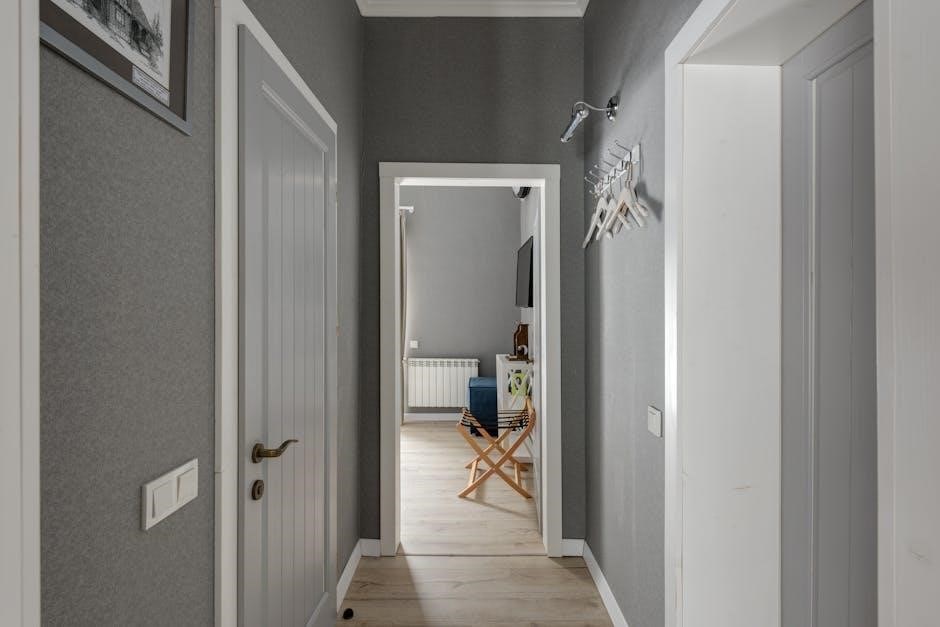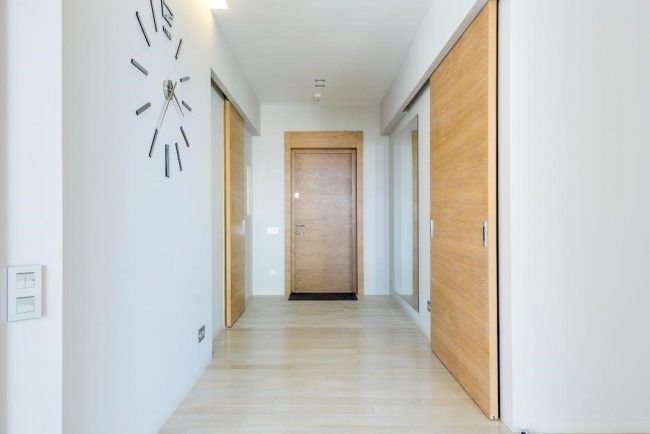Door guides are essential components that ensure smooth operation and proper alignment of sliding doors, enhancing functionality and safety in various residential and commercial settings.
What Are Door Guides?
Door guides are specialized mechanisms designed to ensure the smooth and consistent movement of sliding doors. They help maintain proper alignment, preventing doors from swaying or derailing. Typically, these guides are mounted on the floor, wall, or overhead, providing stability and control. By keeping the door on its intended path, they enhance functionality and safety. Door guides are essential for maintaining the longevity of sliding door systems, reducing wear and tear, and ensuring seamless operation over time. They are a crucial component in both residential and commercial settings, offering practical solutions for various door types and sizes.
Why Are Door Guides Important for Sliding Doors?
Door guides play a critical role in ensuring the smooth operation and longevity of sliding doors. They prevent doors from derailing, reducing wear and tear on the track and surrounding structure. Proper alignment maintained by door guides minimizes the risk of damage from misalignment, which can lead to costly repairs. Additionally, they enhance safety by keeping doors stable, reducing the likelihood of accidents. Door guides also improve energy efficiency by ensuring a tight seal, which helps regulate temperature and reduce drafts. Overall, they are essential for maintaining functionality, safety, and energy efficiency in both residential and commercial sliding door systems.

Types of Door Guides
Sliding door guides are categorized into floor-mounted, wall-mounted, and overhead types, each offering unique installation options to suit different door systems and architectural designs effectively;
Floor-Mounted Door Guides
Floor-mounted door guides are installed directly on the floor, providing stability and alignment for sliding doors. They are ideal for heavy doors and high-traffic areas, ensuring smooth operation. These guides often feature adjustable components to accommodate varying door weights and sizes. Installation typically involves securing brackets to the floor, which hold rollers or glides attached to the door. Maintenance involves regular cleaning and lubrication to prevent wear and tear. Their durability makes them a popular choice for both residential and commercial settings, offering a reliable solution for ensuring doors move seamlessly along their intended path without deviation or obstruction. They are also versatile, fitting various door materials and designs, making them a practical option for different architectural needs.
Wall-Mounted Door Guides
Wall-mounted door guides are installed on the adjacent wall, providing support and alignment for sliding doors without requiring floor space. They are ideal for doors made of glass, wood, or metal, offering a sleek and modern aesthetic. These guides typically consist of brackets or tracks attached to the wall, with rollers or glides secured to the door. They are easy to install and adjust, making them a popular choice for homeowners and designers. Wall-mounted guides are particularly useful in tight spaces, as they do not obstruct the floor. Regular cleaning and lubrication ensure smooth operation, while their durable construction withstands heavy use. They are versatile, suitable for both residential and commercial applications, and can be customized to match various interior designs. This makes them a practical and stylish solution for maintaining door alignment and functionality.
Overhead Door Guides
Overhead door guides are installed above the sliding door, typically utilizing a track or roller system suspended from the ceiling or a header. These guides are ideal for heavy doors, such as large glass panels or commercial sliding doors, as they provide superior stability and prevent swaying. Made from durable materials like stainless steel or aluminum, overhead guides are designed to withstand heavy use and last for years. Installation requires careful alignment and structural support to ensure the weight is evenly distributed. Regular maintenance, including cleaning and lubricating the rollers, is essential for smooth operation. Overhead door guides are a practical solution for maintaining proper door alignment while keeping the floor clear, making them a popular choice for modern designs.

Materials and Hardware
High-quality materials like stainless steel, aluminum, and brass are commonly used for durability and corrosion resistance, while key hardware includes rollers, tracks, and brackets for smooth operation.
Common Materials Used
Door guides for sliding doors are typically made from durable materials such as stainless steel, aluminum, and brass, which offer excellent corrosion resistance and longevity. Stainless steel is ideal for outdoor applications due to its weather-resistant properties, while aluminum is lightweight and cost-effective. Brass is often chosen for its strength and aesthetic appeal. Additionally, nylon and plastic components are used for their self-lubricating properties, reducing friction and noise during operation. These materials ensure smooth functionality and withstand heavy use, making them suitable for both residential and commercial settings. Proper material selection is crucial for maintaining the performance and lifespan of sliding door systems.

Key Hardware Components
Sliding door guides rely on several key hardware components to ensure smooth and reliable operation. The track, typically mounted on the floor or wall, serves as the guiding rail for the door. Rollers or wheels attached to the door move along the track, reducing friction and wear. Brackets secure the track in place, while adjustable stops prevent the door from derailing. Additional components like handles and locks enhance functionality and security. High-quality hardware ensures durability and quiet operation, making these systems suitable for various applications. Proper alignment and installation of these components are essential for optimal performance and longevity.

Installation Considerations
Proper installation requires precise measuring, alignment, and securing of tracks and brackets to ensure smooth door operation and prevent wear over time.

Measuring and Alignment
Accurate measuring ensures proper fit and functionality of sliding doors. Start by assessing the doorway’s width, height, and frame type. Use a level to check alignment, ensuring tracks are parallel and evenly spaced. Mark mounting points precisely, considering the door’s weight and movement range. Double-check measurements to avoid installation errors. Proper alignment prevents door binding and extends hardware lifespan. Use shims if necessary to adjust for uneven surfaces. Finally, test the door’s smooth operation before securing all components. Attention to detail here guarantees a professional finish and reliable door performance over time.
Tools and Techniques
Installing door guides requires specific tools for accuracy and efficiency. A drill, screwdrivers, and a level are essential for securing tracks and ensuring proper alignment. Use measuring tapes to mark precise mounting points. Pencil marks guide drill holes, preventing mistakes. For heavier doors, consider using lag bolts for added stability. Pre-drilling holes can prevent material splitting. Apply silicone spray or lubricant to moving parts for smooth operation. Use shims to adjust alignment if needed. Test the door’s movement after installation to ensure seamless functionality. Proper techniques ensure durability and optimal performance, making the installation process both effective and long-lasting.

Maintenance and Adjustment
Regular cleaning and lubrication of door guides ensure smooth operation and extend their lifespan. Adjustments may be needed to maintain proper alignment and functionality over time.
Cleaning and Lubrication
Regular cleaning and lubrication are crucial for maintaining the efficiency of door guides. Use a soft cloth and mild detergent to remove dirt and debris from the tracks and rollers. Avoid harsh chemicals or abrasive materials that could damage the surfaces. Apply silicone-based lubricants to moving parts to reduce friction and ensure smooth operation. Proper lubrication prevents squeaking and extends the lifespan of the hardware. For best results, clean and lubricate the guides every 3–6 months, depending on usage. Regular maintenance ensures the sliding doors operate seamlessly, providing both functionality and longevity to the system.
Troubleshooting Common Issues
Common issues with door guides include misalignment, obstructions, or wear and tear. If the door doesn’t slide smoothly, check for debris or dirt in the track. Clean the area thoroughly and ensure the guide is properly aligned. Lubricate moving parts if they feel stiff or squeaky. Loose hardware can cause instability, so tighten any screws or bolts. If the door still doesn’t function correctly, inspect for worn-out rollers or damaged tracks, which may need replacement. Addressing these issues promptly prevents further damage and ensures smooth operation. Regular maintenance can help avoid many of these problems, keeping your sliding doors functioning efficiently and reliably over time.

Integration with Smart Home Technology
Modern door guides integrate seamlessly with smart home systems, offering automated control via voice commands or smartphone apps, enhancing convenience and energy efficiency in home automation setups.
Automated Door Guides
Automated door guides represent the fusion of modern technology and convenience, enabling sliding doors to open and close effortlessly through motorized systems. These systems are typically controlled via smart home hubs, voice assistants, or smartphone apps, offering unparalleled ease of use. By integrating sensors and quiet motors, automated door guides ensure smooth operation while maintaining a sleek, contemporary aesthetic. They are particularly beneficial for large or heavy sliding doors, eliminating the need for manual effort. Additionally, these systems often include safety features like obstacle detection, preventing accidents and enhancing overall user experience. This innovation not only adds convenience but also boosts the energy efficiency of sliding door mechanisms.
Smart Sensors and Safety Features
Smart sensors and safety features are integral to modern sliding door systems, enhancing user security and convenience. These sensors detect obstacles, preventing doors from closing on people or objects, thus avoiding accidents. Motion sensors can automatically open or close doors, while pressure sensors ensure gentle operation. Some systems include anti-theft mechanisms, such as electronic locks, to secure doors when closed. Integration with smart home technology allows users to monitor door status remotely, adding an extra layer of safety. These features not only improve functionality but also provide peace of mind, making sliding doors a reliable choice for homes and commercial spaces. They adapt to various needs, ensuring efficiency and safety.

Safety and Security Features
Safety and security features in sliding door systems enhance protection through advanced technology, ensuring reliable operation and secure locking mechanisms to safeguard against unauthorized access and potential hazards.
Child and Pet Safety
Ensuring the safety of children and pets around sliding doors is crucial. Door guides can be equipped with soft-close mechanisms to prevent accidental pinching or crushing. Additionally, installing safety sensors that detect obstacles, such as a child or pet, can halt door movement immediately. Some systems include tamper-proof locks and secure handles to prevent unauthorized opening by children. Pet owners can also benefit from guides that allow for smooth door operation, reducing the risk of pets slipping through or getting injured. These features collectively create a safer environment for families with children and pets, offering peace of mind and enhanced security.
Anti-Theft Mechanisms
Anti-theft mechanisms in sliding door guides are designed to enhance security and prevent unauthorized access. These systems often include locking mechanisms that securely fasten the door in place, making it difficult to force open. Some door guides feature reinforced hardware, such as tamper-proof screws and robust brackets, to withstand break-in attempts. Additionally, certain models incorporate anti-lift devices that prevent the door from being lifted off its track, a common method of forced entry. These mechanisms not only protect against theft but also ensure the door remains stable and secure, providing homeowners and businesses with an added layer of safety and peace of mind.

Future Trends in Sliding Door Guides
Future trends emphasize smart home integration, automated systems, and sustainable materials, enhancing functionality, energy efficiency, and design aesthetics for sliding doors.
Innovative Materials and Designs
Recent advancements in door guide technology have introduced innovative materials and designs, focusing on durability, aesthetics, and functionality. High-strength, lightweight alloys and corrosion-resistant stainless steel are now commonly used, ensuring longevity and minimal maintenance. Designers are also incorporating sleek, minimalist profiles that blend seamlessly with modern interiors. Smart materials, such as self-lubricating polymers, reduce friction and wear, while eco-friendly options like recycled aluminum align with sustainable building trends. Additionally, customizable designs allow for tailored solutions to meet specific architectural needs, enhancing both performance and visual appeal. These innovations are reshaping the future of sliding door systems, making them more efficient and visually striking than ever before.
Energy Efficiency and Sustainability
Modern door guides are increasingly designed with energy efficiency and sustainability in mind. By minimizing air leakage and ensuring proper door alignment, they contribute to reduced heating and cooling costs. Eco-friendly materials, such as recycled aluminum and sustainably sourced wood, are now widely used, lowering the environmental footprint of sliding door systems. Additionally, advanced sealing technologies and thermal breaks in door guides help maintain consistent indoor temperatures, further enhancing energy efficiency. These innovations not only promote environmental responsibility but also align with global efforts to create greener, more energy-conscious buildings, making sliding doors a practical and sustainable choice for contemporary spaces.
Door guides for sliding doors are indispensable for ensuring smooth operation, safety, and energy efficiency. By providing proper alignment and support, they enhance functionality while protecting the door and surrounding structure. With various types and materials available, homeowners and builders can choose options that suit their needs, from durability to aesthetic appeal. Regular maintenance, such as cleaning and lubrication, ensures longevity and optimal performance. As technology advances, innovative designs and sustainable materials are reshaping the future of sliding door systems. Whether for residential or commercial use, door guides play a crucial role in creating efficient, secure, and stylish spaces, making them a vital component in modern architecture.
